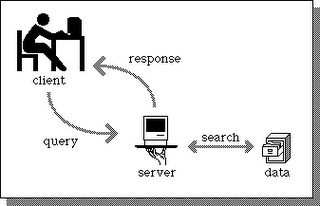CLIENT/SERVER MODEL OF COMPUTING
Another type of network architecture is known as a peer-to-peer architecture because each node has equivalent responsibilities. Both client/server and peer-to-peer architectures are widely used, and each has unique advantages and disadvantages.
Client-server architectures are sometimes called two-tier architectures.
Handle the user interface.
Translate the user's request into the desired protocol.
Send the request to the server.
Wait for the server's response.
Translate the response into "human-readable" results.
Present the results to the user.
The server's functions include:
Listen for a client's query.
Process that query.
Return the results back to the client.
A typical client/server interaction goes like this:
The user runs client software to create a query.
The client connects to the server.
The client sends the query to the server.
The server analyzes the query.
The server computes the results of the query.
The server sends the results to the client.
The client presents the results to the user.
Repeat as necessary.

Clients could be also written for DOS- or UNIX-based computers. This allows information to be stored in a central server and disseminated to different types of remote computers. Since the user interface is the responsibility of the client, the server has more computing resources to spend on analyzing queries and disseminating information. This is another major advantage of client/server computing; it tends to use the strengths of divergent computing platforms to create more powerful applications. Although its computing and storage capabilities are dwarfed by those of the mainframe, there is no reason why a Macintosh could not be used as a server for less demanding applications.
In short, client/server computing provides a mechanism for disparate computers to cooperate on a single computing task.
Client/server describes the relationship between two computer programs in which one program, the client, makes a service request from another program, the server, which fulfills the request. Although the client/server idea can be used by programs within a single computer, it is a more important idea in a network. In a network, the client/server model provides a convenient way to interconnect programs that are distributed efficiently across different locations. Computer transactions using the client/server model are very common. For example, to check your bank account from your computer, a client program in your computer forwards your request to a server program at the bank. That program may in turn forward the request to its own client program that sends a request to a database server at another bank computer to retrieve your account balance. The balance is returned back to the bank data client, which in turn serves it back to the client in your personal computer, which displays the information for you.
The client/server model has become one of the central ideas of network computing. Most business applications being written today use the client/server model. So does the Internet's main program, TCP/IP. In marketing, the term has been used to distinguish distributed computing by smaller dispersed computers from the "monolithic" centralized computing of mainframe computers. But this distinction has largely disappeared as mainframes and their applications have also turned to the client/server model and become part of network computing.
In the usual client/server model, one server, sometimes called a daemon, is activated and awaits client requests. Typically, multiple client programs share the services of a common server program. Both client programs and server programs are often part of a larger program or application. Relative to the Internet, your Web browser is a client program that requests services (the sending of Web pages or files) from a Web server (which technically is called a Hypertext Transport Protocol or HTTP server) in another computer somewhere on the Internet. Similarly, your computer with TCP/IP installed allows you to make client requests for files from File Transfer Protocol (FTP) servers in other computers on the Internet.
Other program relationship models included master/slave, with one program being in charge of all other programs, and peer-to-peer, with either of two programs able to initiate a transaction.


0 Comments:
Post a Comment
<< Home